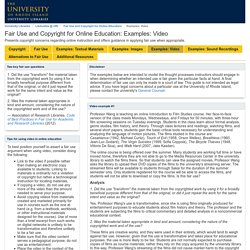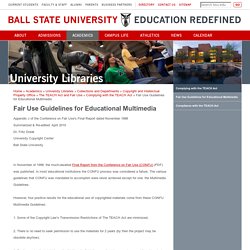

Examples: Video - Fair Use and Copyright for Online Education - LibGuides @ URI at University of Rhode Island. Professor Wang is teaching an online Introduction to Film Studies course.

Her face-to-face version of the class meets Mondays, Wednesdays, and Fridays for 50 minutes, with three-hour film screening sessions on Tuesday evenings. Students in the class learn about formal analysis, genre studies, film history, and theory. Through class lectures and readings, watching films, and several short papers, students gain the basic critical tools necessary for understanding and analyzing the language of motion pictures. The films studied in the course are: Casablanca (1942, Michael Curtiz), Touch of Evil (1958, Orson Welles), Breathless (1960, Jean-Luc Godard), The Virgin Suicides (1999, Sofia Coppola), The Bicycle Thieves (1948, Vittorio De Sica), and Walk Hard (2007, Jake Kasdan). The online course is being offered over the summer. Analysis 1. 2. These films are creative works, and they were used in their entirety, which would tend to weigh against fair use. Fair Use: A video by Google Copyright Attorney, Fred von Lohmann. February 26, 2015 LJ INFOdocket Information Industry News and Resources from Gary Price You are here: Home / Uncat / Video: A Helpful Introduction to Key Fair Use Concepts by Google Copyright Attorney, Fred von Lohmann Video: A Helpful Introduction to Key Fair Use Concepts by Google Copyright Attorney, Fred von Lohmann Filed by Gary Price on February 24, 2015 Fair Use Week 2015 coordinated by the Association of Research Libraries (ARL) is now underway.

A number of events are taking place this week and they’re listed on the Fair Use Week calendar with additional news and useful resources available on the FairUseWeek.org web site. Here are two videos and a new infographic commissioned by ARL that we think are worth knowing about. Introduction and Welcome to Fair Use Week 2015 by Kyle Courtney, Copyright Advisor, Harvard U. Code of Best Practices in Fair Use. Embed imageView/download PDFThe Association of Research Libraries (ARL) presents the Code of Best Practices in Fair Use for Academic and Research Libraries (PDF), a clear and easy-to-use statement of fair and reasonable approaches to fair use developed by and for librarians who support academic inquiry and higher education.

The Code was developed in partnership with the Center for Social Media and the Washington College of Law at American University. In dozens of interviews with veteran research and academic librarians, the researchers learned how copyright law comes into play as interviewees performed core library functions. Then, in a series of small group discussions held with library policymakers around the country, the research team developed a consensus approach to applying fair use. Can We Strengthen our Fragile Public Domain? Each year the copyright community celebrates January 1 as “Public Domain Day.”

That is because a convenient fiction included in most nations’ copyright laws says that if a work’s term of protection expired during the previous year, it officially enters the public domain on the following January 1st. Instead of having to figure out the exact day of an author’s death, and having different works enter the public domain each day, we just save them all up, so that all the works whose term expired in 2014 (i.e., all works whose authors died 70 years earlier, in 1944) entered the public domain on New Year’s Day 2015. At least, they did in most other countries, but not in the U.S. Because of the bizarre arithmetic of our copyright term, published works that entered the public domain elsewhere this year remain locked in copyright in the United States. When we changed our copyright term in 1978 to life plus 50 years—and later, 70 years—we did so only prospectively.
Determining Fair use. Determining fair use There is, unfortunately, no simple definition of "fair use.

" It is a right set forth in he U.S. Copyright Act, but how and when it may be applied is left to the discretion of judges and juries. Be aware that no guidelines provided in this article are guaranteed to be accepted by all courts! Fair Use Guidelines for Educational Multimedia. Appendix J of the Conference on Fair Use's Final Report dated November 1998 Summarized & Re-edited: April 2010 Dr.

Fritz Dolak University Copyright Center Ball State University In November of 1998, the much-awaited Final Report from the Conference on Fair Use (CONFU) (PDF) was published. In most educational institutions the CONFU process was considered a failure. The various guidelines that CONFU was mandated to accomplish were never achieved except for one: the Multimedia Guidelines. However, four positive results for the educational use of copyrighted materials come from these CONFU Multimedia Guidelines: 1. 2. 3. 4. It must be noted and emphasized that certain restrictions and portion limitations of copyrighted works apply and must be complied with and are extracted from the Multimedia Guidelines and reproduced below. 1.3: Applicability : Fair use analysis is maintained for the use of copyrighted materials. 3.2: Educator Use 4.0: Limitations 4.1 Time limit: up to 2 years.
Fair Use Guidelines for Students - Copyright and Fair Use for Students and Faculty. These Guidelines tell us how much of the copyrighted material we can use without violating copyright laws.

The Guidelines cover text, data, illustrations, photographs, movies, plays, TV shows, videos, music, lyrics and downloading from the Internet. Students and teachers creating educational materials must follow the guidelines and remember to cite the authors of any work they copy. Fair Use: Visual Arts.